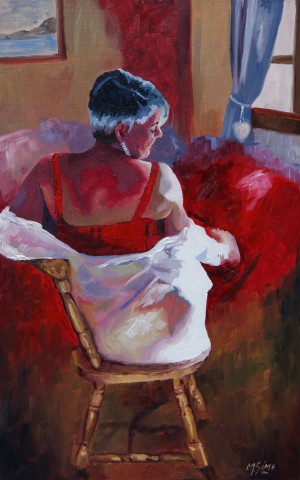Discover the Best Tips for Creating Stunning Figurative Oil Painting Artwork
Discover the Best Tips for Creating Stunning Figurative Oil Painting Artwork
Blog Article
The Duty of Emotion and Expression in Figurative Oil Paint: A Comprehensive Analysis of Topic and Structure
The interaction of emotion and expression in figurative oil paint serves as an essential lens through which one can check out the elaborate connection in between subject issue and structure. Artists harness numerous techniques, from shade choice to brushstroke characteristics, to cultivate psychological vibration within their works.
Recognizing Emotion in Art
Feeling in art works as a powerful channel for expression, allowing artists to communicate complicated feelings through their work. In metaphorical oil paint, this emotional deepness is often depicted through the depiction of the human number, recording the nuances of human experience. The option of subject issue, color scheme, and brushwork all add to the emotional resonance of a piece.
Artists often attract upon individual experiences, societal issues, or global themes to evoke sensations in the customer. As an example, a picture might mirror vulnerability, while a vibrant number in motion can symbolize freedom or chaos. These psychological strings attach the visitor to the art work, cultivating a dialogue that transcends the visual medium.
Furthermore, the interplay between light and shadow can magnify psychological intensity, leading the audience's look and drawing attention to certain components within the structure. Making use of structure in oil painting additionally adds layers of intricacy, welcoming a responsive response that enhances the emotional experience. Overall, understanding emotion in art is vital for valuing the subtleties that characterize figurative oil painting, as it changes plain representation right into an extensive exploration of the human condition.
Key Aspects of Make-up
In the world of figurative oil painting, the composition acts as the underlying structure that organizes aesthetic components and improves the emotional story. Important parts of structure include equilibrium, contrast, focal point, and rhythm, each adding to the total effect of the artwork.
Balance refers to the distribution of aesthetic weight within the painting, which can be attained with symmetrical or unbalanced arrangements. A well-balanced composition provides stability, enabling the audience to involve with the item harmoniously - figurative oil painting. Comparison, on the other hand, involves comparing different aspects, such as light and dark or cozy and great colors, to lead the audience's eye and stimulate emotional feedbacks
The focal point is important, as it routes focus to the most substantial part of the paint, frequently highlighting the emotional core of the story. By skillfully integrating these crucial aspects, musicians can craft emotionally resonant and compelling figurative oil paintings that mesmerize and involve their audience.
Subject and Its Influence
Topic plays a pivotal duty in figurative oil paint, as it not just acts as the structure for the story yet additionally forms the visitor's interpretation and emotional engagement with the art work. The selection of subject issue-- be it a singular figure, a group dynamic, or a thematic representation-- directly affects the emotional atmosphere communicated to the audience.

For example, pictures frequently evoke individual links, revealing the details of human expression and character, while scenes portraying communal activities can develop a feeling of belonging or nostalgia. Moreover, the historic and cultural context of the subject enriches the audience's understanding, prompting much deeper reflections on social standards, values, and the human problem.
Various topics also produce differing degrees of interaction; a remarkable problem portrayed through figures in tension might elicit sensations of stress and anxiety or empathy, while serene landscapes can conjure my website up serenity and consideration. Eventually, the influence of topic in figurative oil painting is extensive, as it works as a conduit for emotional resonance, assisting the viewer's feedback and interpretation, and cultivating a connection between the viewer and the art work. This interaction is essential for check my reference the effective interaction of the musician's intent.
Techniques for Stimulating Feelings
The effectiveness of metaphorical oil painting in communicating emotions is substantially affected by the techniques used by the musician. Among one of the most essential techniques is making use of color theory, where the critical selection of colors can evoke particular psychological feedbacks. Cozy shades, such as oranges and reds, usually elicit feelings of enthusiasm or aggressiveness, while cooler tones like blues and greens tend to evoke calmness or sadness.
One more necessary strategy is the control of light and darkness, understood as chiaroscuro. This technique improves the three-dimensionality of figures, producing remarkable contrasts that can heighten emotional deepness. The positioning of light can guide audiences' emotions, highlighting certain components of the composition.
Brushwork likewise plays a crucial function; loose, meaningful strokes can communicate power and spontaneity, whereas smoother techniques might suggest serenity or precision. The plan of subjects within the make-up can affect emotional impact. Close closeness can recommend affection, while range may suggest isolation.
Eventually, the mix of these techniques enables artists to craft narratives that reverberate with the audience, transforming a plain aesthetic experience right into an expressive emotional journey. - figurative oil painting

Study of Notable Functions
Taking a look at remarkable straight from the source works of metaphorical oil painting discloses exactly how numerous methods are used to stimulate effective emotions. One excellent case is Edvard Munch's "The Scream," where the altered figure and swirling history convey existential dread. Munch's use color-- deep blues and brilliant oranges-- intensifies the emotional impact, showcasing exactly how scheme options can form audience experience.
Another considerable work is Pablo Picasso's "Les Demoiselles d'Avignon." Here, strong brushstrokes and fragmented types reflect a troubled emotional landscape, testing conventional depictions of the female figure. Picasso's ingenious make-up not only records the visitor's attention yet additionally welcomes contemplation on themes of identity and sexuality.
In Addition, Frida Kahlo's "Both Fridas" offers a touching expedition of duality and self-identity. The different numbers, linked by a shared heart, exhibit Kahlo's emotional deepness and individual story. figurative oil painting. Her meticulous attention to information and symbolic components offer to involve viewers on a natural degree
These case studies underscore the profound connection between emotion and make-up in figurative oil paint, revealing exactly how artists harness strategy to communicate complex feelings and stories that resonate across time and society.

Verdict
In conclusion, the interaction of feeling and expression in figurative oil paint significantly boosts the visitor's experience and interpretation of the art work. Via a careful option of subject matter and compositional techniques, artists convey extensive narratives that reverberate on both personal and universal degrees. The application of color brushwork, theory, and chiaroscuro additional intensifies emotional depth, changing each canvas right into a powerful reflection of the complexities of the human experience.
In metaphorical oil painting, this emotional depth is commonly represented with the representation of the human figure, capturing the nuances of human experience.Moreover, the interplay between light and shadow can amplify emotional strength, guiding the audience's gaze and drawing interest to particular elements within the make-up. The usage of appearance in oil painting even more adds layers of intricacy, inviting a responsive reaction that enhances the psychological experience.The focal factor is critical, as it guides focus to the most significant component of the paint, commonly highlighting the psychological core of the narrative. Ultimately, the impact of subject matter in metaphorical oil painting is profound, as it offers as an avenue for psychological resonance, leading the viewer's feedback and interpretation, and promoting a connection in between the art work and the observer.
Report this page